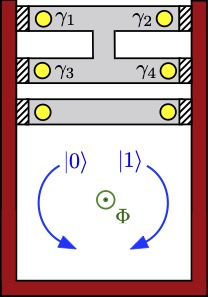Utilizing topological properties of quantum mechanical wavefunctions for storing quantum information constitutes a promising route to error-protected quantum computing that has witnessed noteworthy advancements in recent years. However, there are still important outstanding challenges. Primarily, the generation and clear identification of topological wavefunctions, known as Majorana zero modes, is still an open question in our community. Similarly, the optimal approach for manipulating topological wavefunctions in alignment with current experimental technology still needs to be established.
In our research, we have explored these two questions from different angles. Jointly with collaborators from MIT, we introduced the first scheme for manipulating Majorana-based qubits using an all-superconducting design that seamlessly integrates with the well-developed superconducting qubit technology. In a collaboration with TU Delft, we have also undertaken first steps towards realizing our proposed platform by developing an approach for parity-readout of subgap states based on supercurrent measurements. Finally, we have also been developing new ways for realizing and controlling Majorana zero modes at effectively zero magnetic field. Such approaches could offer a distinct advantage as strong magnetic field adversely affect the superconducting components in candidate platforms for topological wavefunctions.
Looking ahead, we will continue to be interested in new strategies for realizing Majorana zero modes and in overcoming key challenges such as device disorder, which may lead to non-topological wavefunctions that can closely mimic the behavior of Majorana devices.
- Proposal for a Majorana Superconducting Qubit
- Parity-controlled Josephson effect in a nanowire Cooper pair transistor
- Majorana modes at effectively zero magnetic field, realization and control
- https://journals.aps.org/prl/abstract/10.1103/PhysRevLett.129.227002
- https://journals.aps.org/prl/abstract/10.1103/PhysRevLett.120.267002

